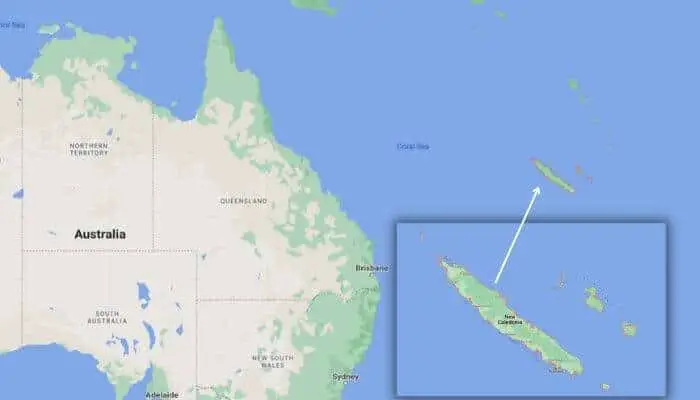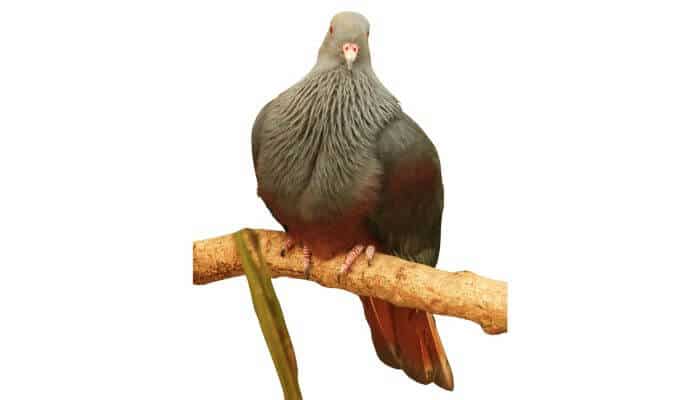The Goliath Imperial Pigeon, also known as the New Caledonian Imperial Pigeon and locally known as Notou, is one of the largest pigeon species in the world.
This pigeon is only found in the humid forests of New Caledonia and is considered a near-threatened species.

The Goliath Imperial Pigeon is commonly hunted for food (illegally and legally).
Origins of the Notou/Goliath Imperial Pigeon
The Goliath Imperial Pigeon was originally described by George Robert Gray as Carpophaga (Phaenorhina) Goliath in 1859.
During his observations, Gray wrote that the Notou’s nostrils were only partly covered and the openings fully exposed which had not been seen in other Columbidae species so therefore “might be supposed to form a subgeneric division, with the name of Phaenorhina”.
This is significant because pigeons are known to be one of just a handful of bird species to have a cere.
The cere is a small, fleshy mound at the base of the upper beak that protects the nostrils. However, the Notou has fully exposed nostrils.
The Goliath Imperial Pigeon (Ducula goliath) is one of 36 species within the Ducula (Imperial Pigeon) genus.
These species are known for being large, arboreal, and mainly fruit-eating.
Distribution & Habitat of the Notou/Goliath Imperial Pigeon
The Goliath Imperial Pigeon is endemic to New Caledonia and is found only on the Isle of Pines and Grande Terre (the main island).

This large bird lives in humid primary forest up to 1,500m in elevation. They can be found in subtropical and tropical moist lowland and montane forests.
The Goliath Imperial Pigeon can usually be seen wherever there are tall trees on the Grande Terre and Isle of Pines.
The birds may also live in small patches of forest along the lower valleys in the south but the Goliath Imperial Pigeon species seems largely restricted to humid forest.
Closest Columbidae Relatives of the Notou/Goliath Imperial Pigeon
The Goliath Imperial Pigeon belongs to the Ducula genus.
According to Derek Goodwin there are 36 species in the Ducula genus, but the number of species is often reported as 34, 36, or 41 depending on the source used.
The species within the Ducula genus are distributed widely between the Himalayas to Polynesia.
Interestingly, Ducula species are noted to have 14 tail feathers compared to Columba species that have 12 tail feathers.
The Ducula species can be separated into 7 subgroups.
The Goliath Imperial Pigeon is categorized into the Brenchleyi species group of chestnut-bellied pigeons.
The species in the group include the:
- Chestnut-Bellied Imperial Pigeon (Ducula brenchleyi)
- Goliath Imperial Pigeon (Ducula goliath)
- Collared Imperial Pigeon (Ducula mullerii)
- Black Imperial Pigeon (Ducula melanochroa)
- Vanuatu Imperial Pigeon (Ducula bakeri)
- Pinon Imperial Pigeon (Ducula pinon)
Notou/Goliath Imperial Pigeon Appearance
The Goliath Imperial Pigeon is one of the largest arboreal pigeon species but it remains slender in appearance.
Two of the most notable features of the Notou are the long strongly-hooked bill and a relatively long tail.

This pigeon is primarily blue-grey in colour with sooty-grey winds and a black tail with a chestnut band.
The Notou has bifurcated feathers on the neck and breast which gives the bird a furrowed appearance with a frosty cast.
The belly and flanks are a purplish-chestnut colour which shades into a paler yellow undertail.
Goliath Imperial Pigeons have bright red eyes with an orange-yellow inner ring, a light pink beak, and pink or red feet.
Although the males and females cannot be separated by appearance, a study of the species found the males were significantly larger (body, wing, and tail length, tarsus length, and head length and width) and heavier than the females.
Males weighed between 712-995g with an average weight of 846.7g while females weighed between 630-890g with an average weight of 785.7g.
Although the males are larger overall it is difficult to judge the sex of the pigeon by appearance only as the eye, bill, and leg colour is similar in both sexes, as is the colour of their plumage.
Juvenile Goliath Imperial Pigeons have duller plumage and do not have bifurcated feathers. The iris is orange and red in juveniles or is dark brown in very young birds.
| Wingspan | Length | Weight | Coloring | |
|---|---|---|---|---|
| Notou/Goliath Imperial Pigeon | 83-97cm | 49-55cm | 630-995g | Bluish grey with purplish-chestnut |
| Average Feral Pigeon | 64 – 72 cm | 32 – 37 cm | 300 – 500 g | Bluish grey with some black |
Facts About The Notou/Goliath Imperial Pigeon
- The Goliath Imperial Pigeon is endemic to New Caledonia
- It is a monotypic species
- Notou is the local name of the Goliath Imperial Pigeon
- It is one of the largest arboreal pigeon species in the world
Notou/Goliath Imperial Pigeon Conservation
The Goliath Imperial Pigeon is categorised as Near Threatened on the IUCN Red List.
This is because, although the species is believed to be currently stable, the Notou population is projected to rapidly reduce in the future as a result of hunting pressure.
There are no recent population figures for the Goliath Imperial Pigeon but in the year 2000 there were thought to be roughly 100,000 individuals.
As the population is unknown, the population trend is also unknown but the species is thought to be declining as a result of hunting and habitat degradation.
One of the main threats to the Notou is hunting. The species could be put at risk if hunting laws relax or hunting seasons change in the future.
Currently the Goliath Imperial Pigeons can be killed legally at certain times of the year.
It is a tradition that the Notou is hunted between late February and early May for traditional ignam feasts and hunting is legal during weekends in April although there is a limit to how many birds each hunter can capture (5 birds per day per hunter).
In addition to legal hunting, the Goliath Imperial Pigeons are shot and killed all year round for the illegal trade; the birds are consumed locally, especially at special events.
Current conservation of the Goliath Imperial Pigeon:
- Protected by law most of the year
Proposed conservation actions:
- Protect lowland forests
- Prevent changes in the law that would extend or change the timing of the hunting season
- Increase awareness of laws concerning the Notou species
Notou/Goliath Imperial Pigeon Character
The Notou is not very social and is often found alone or in pairs.
These pigeons can usually be seen flying high over the forest. They can also be seen in the early morning sitting on high exposed branches and warming themselves in the sun.
Goliath Imperial Pigeons are often quiet, but when they do call the sound is far-carrying through the forest so you may hear them before you can see them.
These pigeons make a low ‘oom’ sound that is constant in pitch and volume but accelerates in rhythm similar to the sound of a ping pong ball being dropped onto a table.
At dusk, the pigeons can be heard make a “gkrarr” trumpet noise.
Notous do not like to come down to the ground so are more likely to be seen sitting on branches high in the trees.
Goliath Imperial Pigeons will sometimes puff out their crop and bow in a display that is similar to the domestic pigeon.
Diet
Goliath Imperial Pigeons eat fruit, flowers, and leaves. They feed on a range of food with 42 different species of fruit and plants identified so far.
This includes Syzygium, Pandanus, Ficus, and Elaeocarpus species.
Notous are known to move around locally to find fruiting trees.
In one study, Notou were found to consume fruits from at least 22 different tree species. They seem to favour small black fruits (species unknown).
The study also found these pigeons consume plant material with leaves representing 7% of the material in the digestive tract.
Mating And Breeding Notou/Goliath Imperial Pigeons
Breeding season for the Goliath Imperial Pigeon is from June to December.
A large 30-40cm nest is made on a branch around 15m off the ground by weaving twigs together.
The female pigeon will lay a single white egg and both parents will incubate the egg and look after the chick.
If the egg is lost then it may be replaced within 12-31 days but this isn’t always the case. There have been instances where two years have passed between breeding attempts.
Caring for Notou/Goliath Imperial Pigeons
This is a wild pigeon species so the best way to care for the Notou is to support conservation measures relating to the protection of the species and their habitat.
These pigeons are not kept as pets.
Although the Goliath Imperial Pigeon is not commonly kept in captivity it seems there are a couple of these birds in zoos.
With that said, we can only find information of the species within the Yokohama Zoological Gardens in Japan dating back to 2020.
